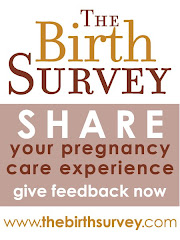Note from Molly: The links to the midwifery editorial referenced below are kind of touch and go. If you have trouble accessing it, go
here and then do a search for the editorial title (The 'Authorities' Resolve Against Home Birth) or for the author's name (Nancy Lowe), and you'll be able to read it that way!
Dear Friends,
The Big Push has issued a news release highlighting the fact that organizations including nurses and perinatal specialists have recently made statements supporting the use of midwives and the choice of out-of-hospital birth. In particular, the editorial by Nancy Lowe, editor of the Journal of Obstetric, Gynecologic, & Neonatal Nursing, the official journal of the Association of Women’s Health, Obstetric and Neonatal Nurses (AWHONN)
here is an especially good statement.
Read the release below, forward it, and follow the links below to read the various statements!
Sincerely,
Susan Hodges, "gatekeeper"
PushNews from The Big Push for Midwives Campaign
CONTACT: Steff Hedenkamp, (816) 506-4630, steff@thebigpushformidwives.org
FOR IMMEDIATE RELEASE: Tuesday, February 17, 2009
Physician Groups Out-of-Step as the Number of Health Care Organizations In Support of Certified Professional Midwives (CPMs) and Out-of-Hospital Birth Rapidly Increases
Nurses, Perinatal Health Care Specialists Echo Consumer Reports Magazine in Calling for Integrating Midwives into U.S. Maternity-Care System
WASHINGTON, D.C. (February 17, 2009)Two major health care organizations have joined the growing number of groups calling on policy makers to increase access to Certified Professional Midwives (CPMs) and out-of-hospital maternity care. Acknowledging the large body of evidence supporting the safety of home delivery with CPMs, who are specifically trained to care for mothers and babies in out-of-hospital settings, nursing and perinatal health care organizations criticized the American Medical Association (AMA) and the American College of Obstetricians and Gynecologists (ACOG) resolutions calling for bans on CPMs and home birth. The groups also joined Consumer Reports magazine in highlighting the need for a major overhaul of the U.S. maternity care system.
"I am very proud to be an American, but I am embarrassed that our country, founded on the ideals of individual liberty and freedom, can also support 'authoritative' initiatives such as these by the ACOG and AMA, initiatives that are founded on neither science nor an understanding of the physiologic and psychosocial needs of mothers and babies," said Nancy K. Lowe in an editorial published in the Journal of Obstetric, Gynecologic, & Neonatal Nursing, the official journal of the Association of Women’s Health, Obstetric and Neonatal Nurses (AWHONN). "What is most risky about home birth in the United States is that for most women who desire it there is a scarcity of qualified providers of home birth services." [Read the complete editorial
here.
Consumer Reports magazine cited the desire for economic gain as one of the driving forces limiting access to CPMs and Certified Nurse-Midwives (CNMs), who are licensed in all 50 states and practice primarily in hospital settings, but who remain subject to anti-competitive regulations promoted by the AMA and ACOG. CPMs are legally authorized to provide out-of-hospital care in just half the states, while advocates working to reform the law in the remaining states face stiff resistance from physician groups seeking to establish a monopoly on the maternity care market in the U.S.
"Midwives provide a safe and cost-effective alternative to the current model, where the market is dominated by high-cost, high-tech specialists producing less-than-optimal outcomes," said Katie Prown of The Big Push for Midwives Campaign. "Babies delivered by midwives are far less likely to be pre-term or low birth-weight, which are two of the leading causes of neonatal mortality and of the enormous costs associated with long-term care. Midwives and out-of-hospital birth are an integral component of responsible health care reform, and the AMA and ACOG know this. That’s why they’re fighting so desperately to protect their turf, even if it means denying women maternity-care options in the process."
The National Perinatal Association (NPA) added to the growing list of organizations calling on the AMA and ACOG to end their vendetta against midwives and home birth and instead follow the World Health Organization’s (WHO) call to "'work in a spirit of recognition and respect for each other’s authority, responsibility, ability and unique contribution.'" [See their statements on place of birth and on midwifery
here.
The Big Push for Midwives is a nationally coordinated campaign to advocate for regulation and licensure of Certified Professional Midwives (CPMs) in all 50 states, the District of Columbia and Puerto Rico, and to push back against the attempts of the American Medical Association Scope of Practice Partnership to deny American families access to legal midwifery care. Through its work with state-level advocates, the Big Push is helping to build a new model of U.S. maternity care built on expanding access to out-of-hospital maternity care and CPMs, who provide affordable, quality, community-based care that is proven to reduce costly and preventable interventions as well as the rate of low birth-weight and premature births.
Media inquiries: Steff Hedenkamp (816) 506-4630, steff@thebigpushformidwives.org.






